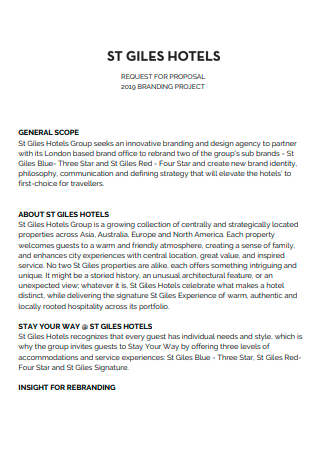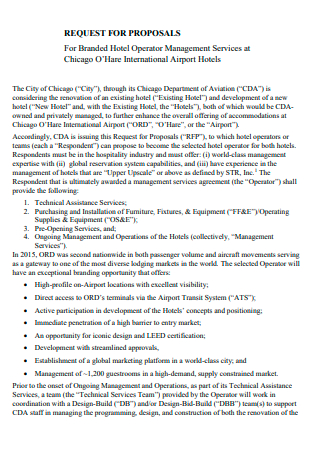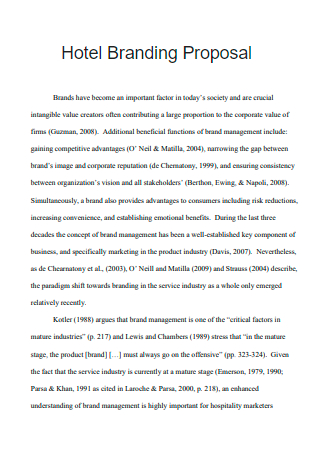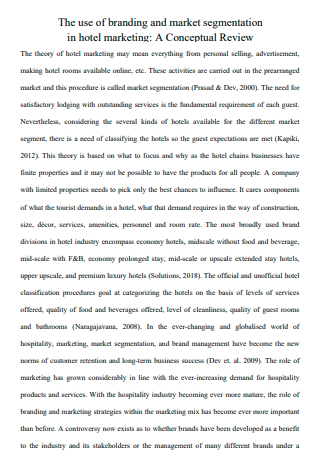3+ Sample Hotel Branding Proposal
FREE Hotel Branding Proposal s to Download
3+ Sample Hotel Branding Proposal
What Is a Hotel Branding Proposal?
Reaping the Benefits of a Strong Branding
Producing an Effective Hotel Branding Proposal
What are the other pro tips when making a hotel branding proposal?
What are the terms and conditions included in a branding proposal?
What are some of the different brand types?
What are some of the elements that make up a brand?
What Is a Hotel Branding Proposal?
A hotel branding proposal is a sales document prepared and presented to convince decision-makers in the hotel business that the type of hotel brand concept created is the one that addresses the needs of the target market. Sounds like a lot to process, doesn’t it? It is a process that persuades the audience that the hotel brand concept is the best one to represent the hotel and its cultures and values. Branding gives the hotel an identity that makes it stand out from its competitors through the use of symbols, logos, slogans, or words, and is also meant to shape its customer’s perception of what hotels should be. Branding is usually done within hotel conglomerates, hotel groups, or hotel franchises. It is meant to distinguish one hotel from the other, and also tells in a way that they all belong to the same company. Take, for instance, the world-famous Hyatt Hotel Corporation. You’d find that the Hyatt is broken down into several hotel brands, such as the Park Hyatt, the Grand Hyatt, the Andaz, the Hyatt Regency, the Hyatt Place, and many more. Investing in having a good hotel brand will prove to be a good move and a strong advantage in the long run for any business since the benefits will exceed expectations.
Reaping the Benefits of a Strong Branding
Branding is an important process of any business’s marketing strategy and oftentimes is considered as the company’s valuable asset. Aside from being a representation of the company’s culture and values, it is also an effective revenue generator. Brands are created to send a message. Brands are designed to promote product loyalty. Brands are made so that people will know that, hey, this is the product that you are looking for! This is what you want. This is what you need. And once the marketing team comes out with an appealing and memorable brand design, you have a winner for your company. Read on to find out more about what are the benefits of a good and strong brand.
Producing an Effective Hotel Branding Proposal
Before any of those benefits from a successful branding takes place, the brand first goes through an intricate process of getting drafted, designed, reviewed, revised, and finally approved by decision-makers. Hours and hours are poured over in creating that perfect proposal that gets a nod and a sign-off to be implemented. The proposal should cover all aspects of what to expect out of a hotel brand and should be able to answer the anticipated questions, such as what the hotel brand is supposed to convey and achieve for the hotel business. There are a lot of formats out there when creating a proposal. What is important, however, is that the essential elements of creating a hotel branding proposal are included and integrated into the process.
-
Step 1: Creating an Outstanding Cover Letter
A Cover Letter should be what the above says: outstanding. To grab the reader’s attention is the sole purpose of having a cover letter. Keeping the reader interested, setting the tone for a call to action is what makes up a good cover letter. A cover letter is designed to introduce, in this case, the hotel brand. The cover letter should contain a brief description of the company or hotel group that owns the proposed hotel brand, or if you’re a third-party, a brief description of the company you represent. The letter should also indicate a quick description of the brand concept, and why that is the best brand concept to choose.
-
Step 2: Writing an Explicit Executive Summary
The Executive Summary provides an overview of the succeeding pages in the hotel branding proposal. It should provide the reason why there is a need for a new hotel brand, what is the reason for choosing that concept, and what it hopes that the brand concept achieves. It also briefly outlines the market condition, the target customer market, and the strategies to be taken in establishing the brand within the market
-
Step 3: Presenting the Proposed Brand
The next section is where you provide more details about the brand concept. Give a quick recap of how the marketing team was able to come up with the brand. Creating a hotel brand involves a lot of steps. One of which is an understanding of the hotel market condition by doing Market Analysis. For example, fictitious Hotel DEF, a hotel owned by the Hotel ABC Groups, is an innovative type of hotel that lets its customers personalize the type of hotel services they want. Doing a market analysis will help to understand if there is a niche for that particular hotel brand. A SWOT Analysis (determining the brand’s Strengths, Weaknesses, Opportunities, and Threats) is oftentimes used when studying the market. Another step when creating the brand is identifying the target market. Coming up with a catchy and appealing brand name comes next, and then the designing stage. The brand should integrate logo designs that are unique, creative, or a design that’s applying the SMART Goal concept ( Specific, Measurable, Achievable, Relevant, and Timely). Having a slogan is an option, but if you choose to have one, a slogan should be short, but powerful enough that it can give a lasting impression on its readers.
-
Step 4: Identifying the Brand Marketing Strategies
Your audience would then like to know more about how you plan to position the new brand in the market. This is where you identify the Brand Marketing Strategies you’ll be taking. For Hotel DEF, the best and fastest way to market and get the word out is through social media marketing and other social networking platforms. Another way to spice up the hotel brand promotion is getting a celebrity or an influencer to promote the hotel. Also, another strategy could be the traditional paid advertisement, where the hotel is introduced through TV commercials, radio broadcasts, billboards, flyers, et cetera.
-
Step 5: Naming the Price
Price here refers to the costs and expenses it takes to do the research and development of the branding, the creating and producing of the brand, and the implementation of the brand across the chosen channel platforms. Like for example in social media. The costs associated with Social Media Marketing include the payment for content creation, building, designing, and maintaining a website, paid advertisements through social networking sites, and the monitoring and analytics report.
-
Step 6: Setting the Timeline
The proposal should also contain the brand’s timeline, which includes the schedule for its design, its reproduction, its release, and distribution. This will give a realistic expectation to the client, or the owner, how long it will take to create and launch a new brand concept, and if the strategies along with it are measurable, viable, and feasible.
FAQs
What are the other pro tips when making a hotel branding proposal?
A nice tip to a hotel branding proposal would be to include quantitative data. People love seeing numbers; it gives a believable feel when it comes to the proposal. Another tip of creating a proposal is going the visual and digital route. More than ever in this day and age, people would like to see a near realistic visual of what the outcome from the proposal looks like. Doing a 3-dimensional presentation video of the hotel brand would be a plus point to your proposal. Or, doing the whole proposal in a video presentation format instead of just the typical paper presentation or slideshows would be a great touch to your branding proposal. Another pro tip is to research, review, and review. It always pays to double-check, triple-check your work. Proofreading is the key. Check the grammar, punctuations, and avoid being redundant or wordy. Use catchy words and phrases that are appealing, at the same time relevant, to your audience.
What are the terms and conditions included in a branding proposal?
The purpose of having terms and conditions is to make sure that all the parties involved perform their obligations, and that the terms and conditions also guarantee them protection in case of any adverse events. Some of the details included in the terms and conditions are the pricing and payment methods, intellectual property rights, provision for changes, privacy and confidentiality issues, a cancellation clause, and a termination clause.
What are some of the different brand types?
Here are some of the common types of brands being used: 1) Product brand – the most popular type of branding. Simply put, these are the products or goods that businesses create their brand around.; 2) Corporate brand – this is a type of brand name that represents the company or the organization as a whole, presenting the company’s culture and values.; 3) Luxury brand – a type of brand characterized by high standard quality, high price tags, rare, and exclusivity.; 4) Global brand – a type of brand that aims for worldwide recognition. Some well-known global brands are Apple, Amazon, Microsoft, McDonald’s, Coca-Cola, and so on.
What are some of the elements that make up a brand?
Logo. A logo is a symbol or a design that represents the personality and characteristics of a company. Next is the color. Color combination is what makes a brand visually appealing to its target market. Next we have is the slogan, or taglines. Slogan is a short catchphrase to grab the attention of the audience to the brand. Also, we have the fonts. Fonts likewise represents the brand’s culture and values, and it also appeals to the audience’s emotions.
An ideal and successful hotel is a result of careful planning. A hotel’s raving positive reviews and feedback is a result of good marketing. And a hotel that becomes the first choice of its target customer market is a result of good strategizing. Before all of these came to fruition, it all began with a simple plan. A proposal. A good and effective hotel branding proposal.
Want to learn how you can come up with that winning proposal hotel branding presentation? Check out our hotel branding proposal templates. They’re very easy to fill out and easy to use as part of your proposal presentation. Download one now, and start showcasing that brilliant hotel branding proposal!




